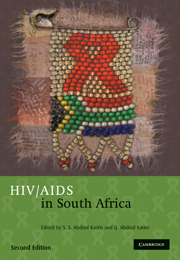Book contents
- Frontmatter
- Contents
- List of Contributors
- Foreword: Peter Piot
- Foreword: Nelson R Mandela
- Acknowledgements
- Section 1 Birth of a rapidly growing epidemic
- Section 2 The virus, the human host and their interactions
- Section 3 HIV risk factors and prevention strategiess
- 9 Reducing sexual risk behaviours: theory and research, successes and challenges
- 10 Barrier methods
- 11 Mother-to-child transmission (MTCT) of HIV-1
- 12 Sexually transmitted infections
- 13 Safe blood supplies
- 14 Intravenous drug use in South Africa
- 15 Positive prevention interventions
- 16 New prevention strategies under development and investigation
- Section 4 Focal groups for understanding the HIV epidemic
- Section 5 The impact of AIDS
- Section 6 Treating HIV
- Section 7 What does the future hold?
- Index
10 - Barrier methods
Published online by Cambridge University Press: 07 September 2011
- Frontmatter
- Contents
- List of Contributors
- Foreword: Peter Piot
- Foreword: Nelson R Mandela
- Acknowledgements
- Section 1 Birth of a rapidly growing epidemic
- Section 2 The virus, the human host and their interactions
- Section 3 HIV risk factors and prevention strategiess
- 9 Reducing sexual risk behaviours: theory and research, successes and challenges
- 10 Barrier methods
- 11 Mother-to-child transmission (MTCT) of HIV-1
- 12 Sexually transmitted infections
- 13 Safe blood supplies
- 14 Intravenous drug use in South Africa
- 15 Positive prevention interventions
- 16 New prevention strategies under development and investigation
- Section 4 Focal groups for understanding the HIV epidemic
- Section 5 The impact of AIDS
- Section 6 Treating HIV
- Section 7 What does the future hold?
- Index
Summary
CONDOMS REMAIN AN EFFECTIVE way to prevent pregnancy and the transmission of sexually transmitted infections (STIs), including HIV. They have a long history, first recorded in ancient Egypt.
Most condoms today are made of latex, but newer materials such as polyurethane are being used, particularly for female condoms. Condoms are often packaged with either a non-allergenic powder or a silicone-based lubricant that may contain a spermicide.
Used correctly, condoms are highly effective in preventing the transmission of hiv and other stis. Studies of serodiscordant couples show that the transmission of hiv is substantially reduced with 100% condom use. Female condoms, used correctly, are as effective in preventing disease transmission as male condoms.
There are three main sources of male and female condoms in South Africa: free through the public sector, through social marketing programmes and through commercial distributors.
Levels of condom use vary widely between groups, but are thought generally to be low in South Africa. Barriers to condom use include perceptions that their use means lack of trust and infidelity, and the social and economic disempowerment of women.
Despite recent advances in other areas of hiv prevention, including behavioural interventions, and microbicides, condoms remain a pivotal part of the fight against hiv/aids. Condoms are inexpensive and relatively easy to use. They provide protection against transmission of hiv and a wide range of other stis as well as pregnancy.
- Type
- Chapter
- Information
- HIV/AIDS in South Africa , pp. 183 - 200Publisher: Cambridge University PressPrint publication year: 2010
- 4
- Cited by



